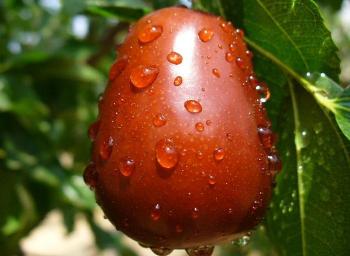(Rhamnaceae family)
The Common Jujube grows naturally in Israel and all over the Mediterranean basin. Its Latin name is Ziziphus spina christi and in Hebrew it is called “Kinar”, “Sheyzaf” or “Dom”. The name “Kinar” is associated with the Sea of Galilee whose Hebrew name is “ Kinneret”. The word “christi” refers to Christ. According to Christian tradition, the “Crown of Thorns” placed on Christ’s head at the time of his crucifixion was made from a branch of this tree. Chinese Jujube is grown to some extent in the Middle East, The Balkans, Russia, North Africa, and The United States but as a commercial crop it is grown primarily in the Far East, in China and Korea. The Chinese Jujube is deciduous and bear fruit at the end of the summer. The Chinese Jujube has been known in the land of Israel for centuries and has an additional name in Arabic “Einab” . The fruit of this local variety is often found in the wild and in old gardens, they resemble small olives, and the trees are the source for rootstocks for the newer varieties which are now available. The fruit ripens just before the Jewish new year and is one of the fruits for which a special blessing called “The Shehekhianu” is said. In the Far East, most of the fruit is sold dry and is used in traditional medicine as a calmant, for the relief of insomnia and as a cure for various hematological and gastric problems. Additionally, the fruit is used as a sweetener with less palatable foods. A decoction of the leaves is said to decrease the desire for sweets
